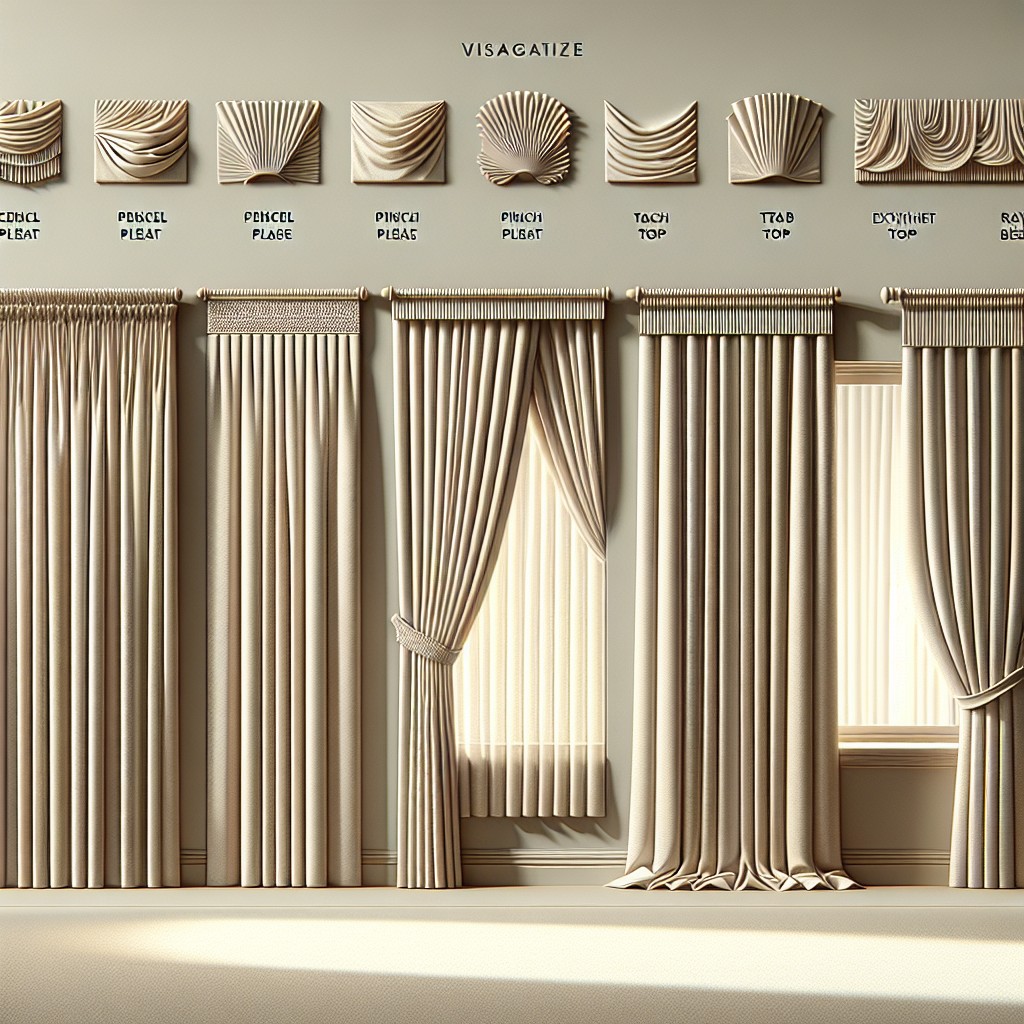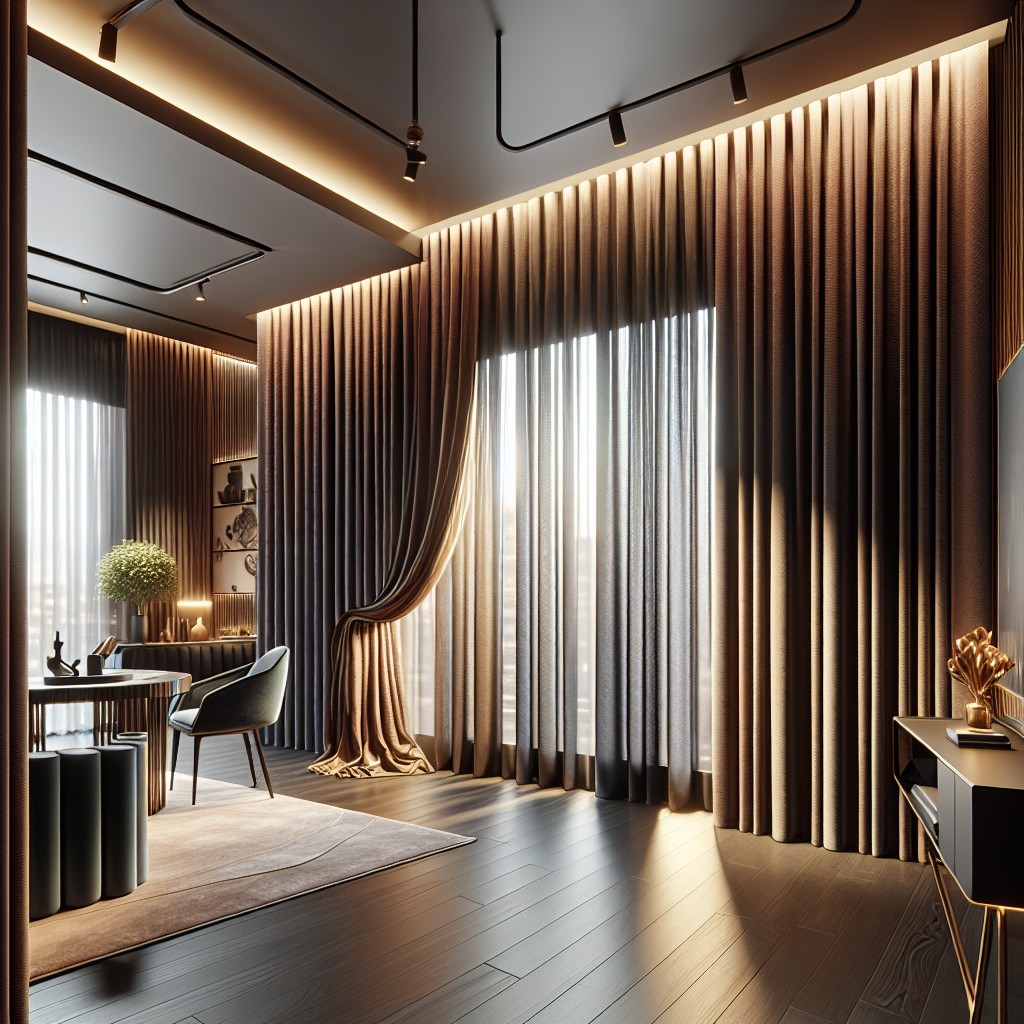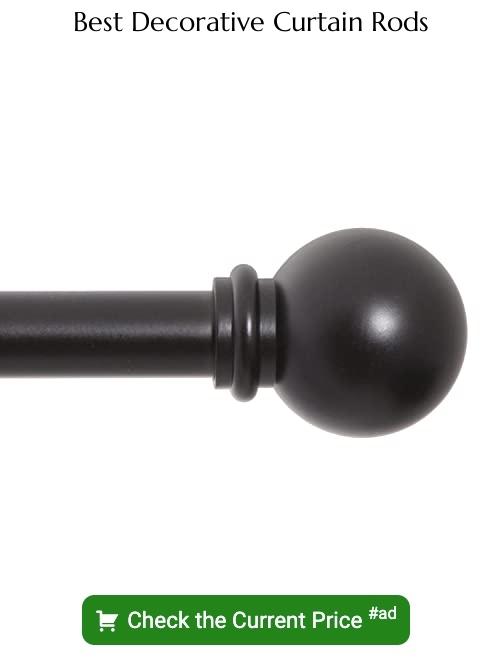Dive into the world of window accents because understanding different curtain header styles can dramatically change the character and ambiance of any room in your home.
Key takeaways:
- Pinch pleat: Versatile, luxurious, and requires maintenance.
- Inverted pleat: Contemporary, neat, and requires sturdy support.
- Goblet pleat: Elegant, sturdy fabric, precise spacing.
- Box pleat: Tailored, structured, best for decorative side panels.
- Grommet: Modern, sleek, practical, and durable.
Overview of Curtain Header Styles

Curtain header styles serve both functional and decorative purposes, determining how the fabric hangs and affects the overall aesthetics of a room. They can accentuate the height of a room, add visual interest, or complement the theme of your decor.
With the right header style, curtains can transform from mere window coverings to stunning design elements that draw the eye and tie a space together. It is crucial to consider the ambiance you wish to create, the ease of operation you prefer, and the type of window you are dressing when choosing a header style.
Each style offers a different level of fullness, stackability, and ease of movement, affecting not just appearance but also functionality.
Pinch Pleat

Pinch pleats are a classic, decorative header option known for their gathered fabric at the top, creating fullness and depth. Fabric is pinched at regular intervals, forming pleats that are sewn in place, delivering an elegant drape.
Here are key points about pinch pleats:
- Versatility: Suitable for both formal and casual spaces due to variations in pleat tightness and spacing.
- Fullness: The gathered fabric creates a luxurious look. For proper fullness, use a curtain width 2-2.5 times the window width.
- Hanging: Requires hooks inserted into the back of the pleat, which can then be hung on rings or a track.
- Maintenance: Given their structured shape, they can require more effort to maintain and may need re-pleating over time.
Inverted Pleat
Characterized by hidden folds, the inverted pleat offers a contemporary aesthetic. This style involves pleats stitched into the back of the curtain panel to create a simple, streamlined appearance from the front. Ideal for heavy fabrics, the inverted pleat maintains a neat look without excessive fullness, making it suitable for both curtains and sheers.
To ensure consistency, spacing between pleats should be even, providing a tailored finish perfect for modern and minimalistic decors. It’s essential to use a sturdy curtain rod to support the pleats’ structure, allowing them to fall crisply and maintain their shape.
Goblet Pleat
Goblet pleat curtains exude elegance, ideal for formal dining rooms or living spaces. Mimicking a goblet’s shape, they begin rounded at the top and taper neatly to a tailored finish.
Fullness is key, and fabrics should be sturdy, such as jacquard or velvet, to maintain the structure. For optimal appearance, filling the pleats with wadding ensures they hold their distinctive form.
These drapes require precise spacing to create a uniform look when hung. While they are typically stationary due to their design, goblet pleats make a luxurious statement in any setting.
Box Pleat
Box pleats offer a tailored and structured look, perfect for both contemporary and traditional decor. The pleats are fashioned by folding the fabric into neat, flat pleats which are then sewn at the top.
Here’s what you should know:
- The hallmark of box pleats is their deep folds, creating a series of rectangular “boxes” for a crisp visual effect.
- This style is conducive to heavier fabrics, as the weight helps maintain the pleat’s shape, providing a uniform fullness.
- When calculating fabric requirements, keep in mind that box pleats are fabric-hungry; the width of the curtain usually needs to be two to three times the width of the window.
- Ideal for stationary curtains, box pleats are not as free-flowing as other styles and are best suited for decorative side panels or valances that don’t need to be drawn frequently.
- For maintenance, regular dusting and periodic steaming are recommended to keep the pleats sharp.
Embrace box pleats for a polished and neat window treatment that makes a statement.
Grommet
Grommet curtain headers, known for their modern and sleek look, incorporate metal rings directly into the fabric. These rings, typically spaced evenly, slide smoothly across a curtain rod, creating uniform, soft folds in the material.
Ideal for heavier fabrics, the grommet design provides a contemporary flair to any room and is incredibly user-friendly due to the ease of movement. They allow for easy opening and closing, making them a practical choice for spaces with frequent window usage.
Additionally, the metal ring reinforcements can prevent fraying, allowing for improved durability. A variety of grommet finishes can also be matched with existing room hardware for a cohesive interior design.
Rod Pocket
This style includes a sewn-in pocket at the top of the curtain panel that slides directly onto the rod, creating a gathered look. It’s a charming option that gives your space a casual, effortless ambiance.
Ideal for lightweight to medium fabrics, this choice ensures a snug fit with no need for additional hardware, making installation a breeze. Keep in mind the channel must be wide enough to accommodate the diameter of your rod, and the unstructured nature of this style means it won’t glide as smoothly when you’re drawing the curtains back and forth.
If you’re aiming for a traditional or shabby chic aesthetic in your space, the rod pocket could be the perfect finishing touch.
Classic Tab Top
Tabs create a casual, yet tailored look for your window treatments. With fabric loops evenly spaced along the top, this style allows for easy sliding along the rod, ensuring smooth operation. The exposed rod between tabs adds a decorative touch, making it a frequent choice where the hardware also serves as an accent.
Choose lightweight to medium-weight fabrics to maintain the tabs’ shape. Consider the size and spacing of the tabs to adjust fullness; wider spacing can result in a flatter appearance while closer tabs provide a fuller look. Avoid heavy, thick materials as they can weigh down the tabs and cause sagging.
Perfect for a laid-back setting, the classic tab top offers an unfussy solution while still keeping a room looking polished. Ideal for children’s rooms or casual living areas, this style invites a welcoming atmosphere.
Wrapped/ Gathered Tab
This header style features fabric loops, often made from the same material as the curtain, that wrap around the rod. The look is casual and airy, lending a touch of understated elegance to the overall aesthetic of the room.
Here are a few points to note about Wrapped/ Gathered Tabs:
- They create an informal, relaxed vibe, suitable for spaces like living rooms or bedrooms.
- The gathers in the fabric provide a soft, flowing appearance as the loops conceal the curtain rod, offering a seamless transition from the curtain to the hardware.
- Versatility in fabric choice can make this style either blend seamlessly with the curtain for a cohesive look or stand out with contrasting textures or colors.
- Easy to install, they simply slide onto the rod, and spacing between loops can be adjusted for more or less gather.
- Maintenance is straightforward, as this style doesn’t require complex hooks or rings, making curtain removal for cleaning hassle-free.
Flowing Style
Flowing style headers exude a casual, airy feel, ideal for creating a relaxed atmosphere in any space. This style typically involves minimal structure, relying on the natural drape of the fabric.
- Utilizing lightweight materials enhances the billowy nature of these curtains.
- Attachment methods may include simple ties or loose loops, allowing the fabric to cascade effortlessly.
- Opt for a flowing style in rooms where natural light is a focal point, as this header type allows for maximum sunlight.
- Maintenance of flowing style curtains is straightforward due to the lack of intricate pleating or folds.
- These headers are versatile, easy to DIY, and suit a wide range of decors, from bohemian to modern minimalist.
Flat Panel Top
Characterized by its minimalist design, the flat panel top lends a modern and casual look to a space. This style involves a piece of fabric with a simple hem, offering a fuss-free aesthetic.
Here’s how it functions:
- Installation: Material is draped over a curtain rod or attached with clips, creating a non-pleated, flat appearance.
- Suitability: Works well with lightweight to medium-weight fabrics for an effortless drape.
- Versatility: Ideal for frequently used spaces — easy to slide and adjust.
- Compatibility: Pairs seamlessly with a hidden track system for a clean, contemporary feel.
- Customization: Length and width can be adjusted to fit any window size, making it a flexible option.
In homes that appreciate understated elegance, the flat panel top is a go-to choice for an uncluttered and chic window dressing.
Add Trimmings to Your Curtains
Embellishing curtains with trimmings can elevate their aesthetic and add a personalized touch to your decor. Here are key points to consider when adding trimmings:
- Trimmings such as tassels, fringe, pom-poms, or lace can be affixed to the edges or bottom of curtain panels for visual interest and texture.
- Contrast piping along the seams or edges can define the curtains’ shape and add a pop of color.
- Beading or sequins offer a sparkle effect, ideal for curtains in rooms where you entertain.
- Ribbon bands or embroidery can inject pattern and detail, drawing the eye up and accentuating the curtain’s design.
- Consider the curtain fabric and room style when choosing trimmings – lighter materials pair well with delicate trimmings, while heavier fabrics can support bolder, chunkier additions.
- For a cohesive look, match trimmings to other textiles in the room, like pillows or upholstery.
- Keep functional aspects in mind, ensuring trimmings do not interfere with the movement or operation of the curtains.
By selecting the right trimmings, you can turn simple curtains into statement pieces that reflect your personal style and attention to detail.
Made to Measure Curtains
Made to measure curtains offer a personalized touch to your living space, ensuring a perfect fit for your windows. Unlike ready-made curtains, this option allows you to customize every detail, including the curtain header style:
- Precision: Curtains are tailored to the exact dimensions of your windows, eliminating issues with curtains being too long or too short.
- Fabric Selection: Choose from a wider range of materials to suit your decor, from sheer voiles to weighty brocades.
- Header Customization: Select a header style that complements your interior design theme and the functional needs of the space.
- Quality Craftsmanship: Expect higher quality due to individual attention to detail and construction by skilled curtain makers.
- Longevity: With proper material and construction, made to measure curtains often last longer than off-the-shelf options.
- Energy Efficiency: Curtains that fit well provide better insulation, which can improve energy efficiency in your home.
By opting for made to measure curtains, you ensure that the investment in your window treatments adds maximum beauty and functionality to your home.
FAQ
What are curtain headings?
Curtain headings are specific styles that govern the draping configuration and stack-back characteristics of a curtain, and an alteration in the heading style can significantly alter the overall look of the finished curtains.
What is the best heading for sheer curtains?
Wave Curtain Heading: The Optimal Choice for Sheer Curtains
What is a rod pocket header?
A rod pocket header is a type of window treatment where fabric is folded over and attached to itself creating a pocket for the drapery rod to slide through, typically used for stationary panels.
What are the benefits and drawbacks of a pinch pleat curtain heading?
Pinch pleat curtain headings offer a classy, tailored look and excellent stack back space efficiency, but they may be more expensive than other styles and require professional or skilled installation.
How does a pencil pleat header affect the overall look of a room?
A pencil pleat header adds a touch of classic elegance to a room, creating a uniform, gathered look that softens the overall aesthetic.
Which curtain header styles are most compatible with blackout curtains?
The curtain header styles most compatible with blackout curtains are rod pocket, grommet, and pinch pleat.
Related Stories
- 15 Euro Pleat Drapery Ideas: An Insightful Comparison
- 15 Kingston Valence Ideas: A Comprehensive Guide to Styles and Inspirations
- 15 Window Valance Styles Ideas to Transform Your Space
- 15 Door Valance Ideas: Your Comprehensive Guide to Styles and Patterns
- 15 Curtain Swag Ideas: Comprehensive Guide to Designs and Valances
Recap

